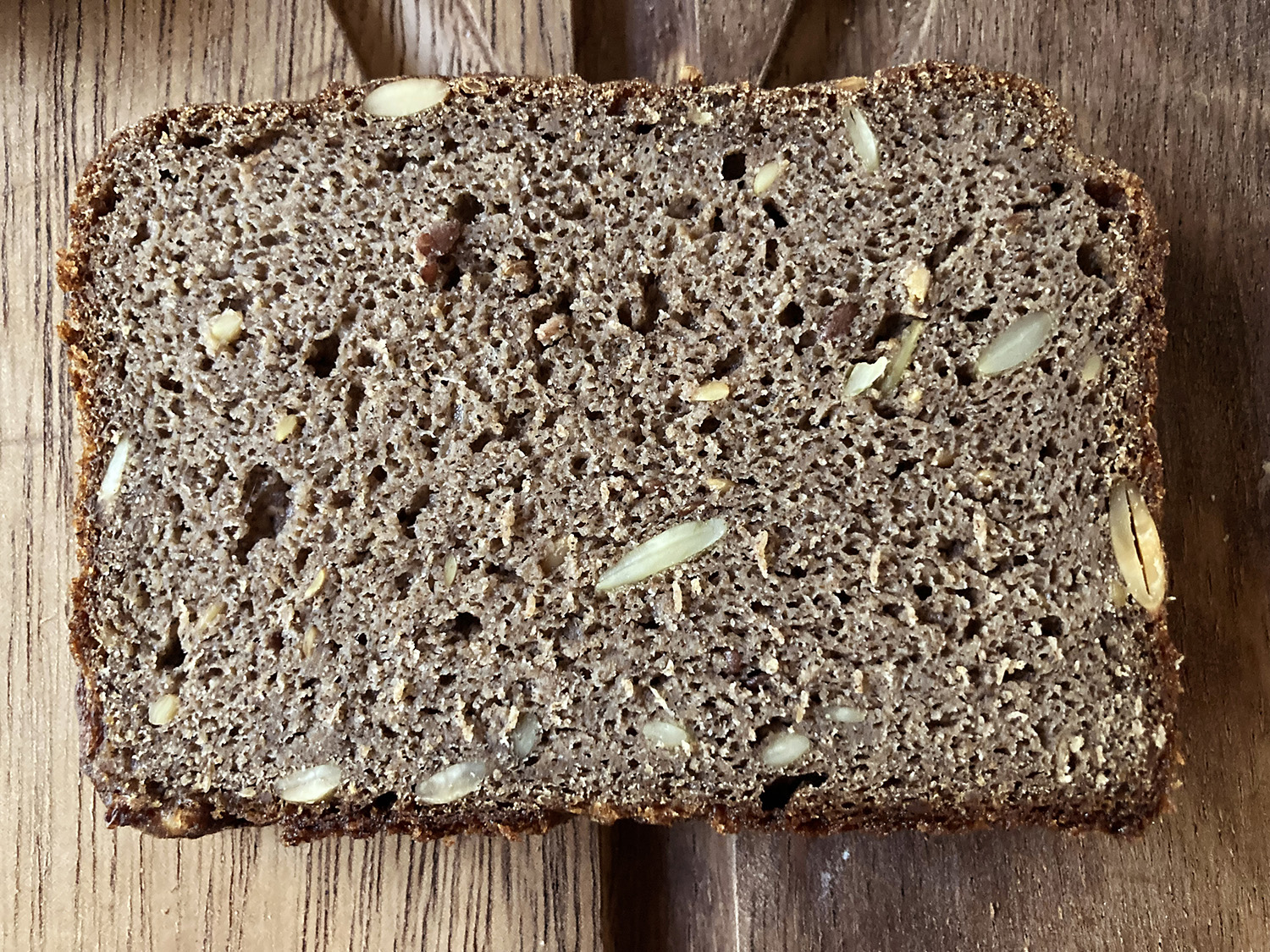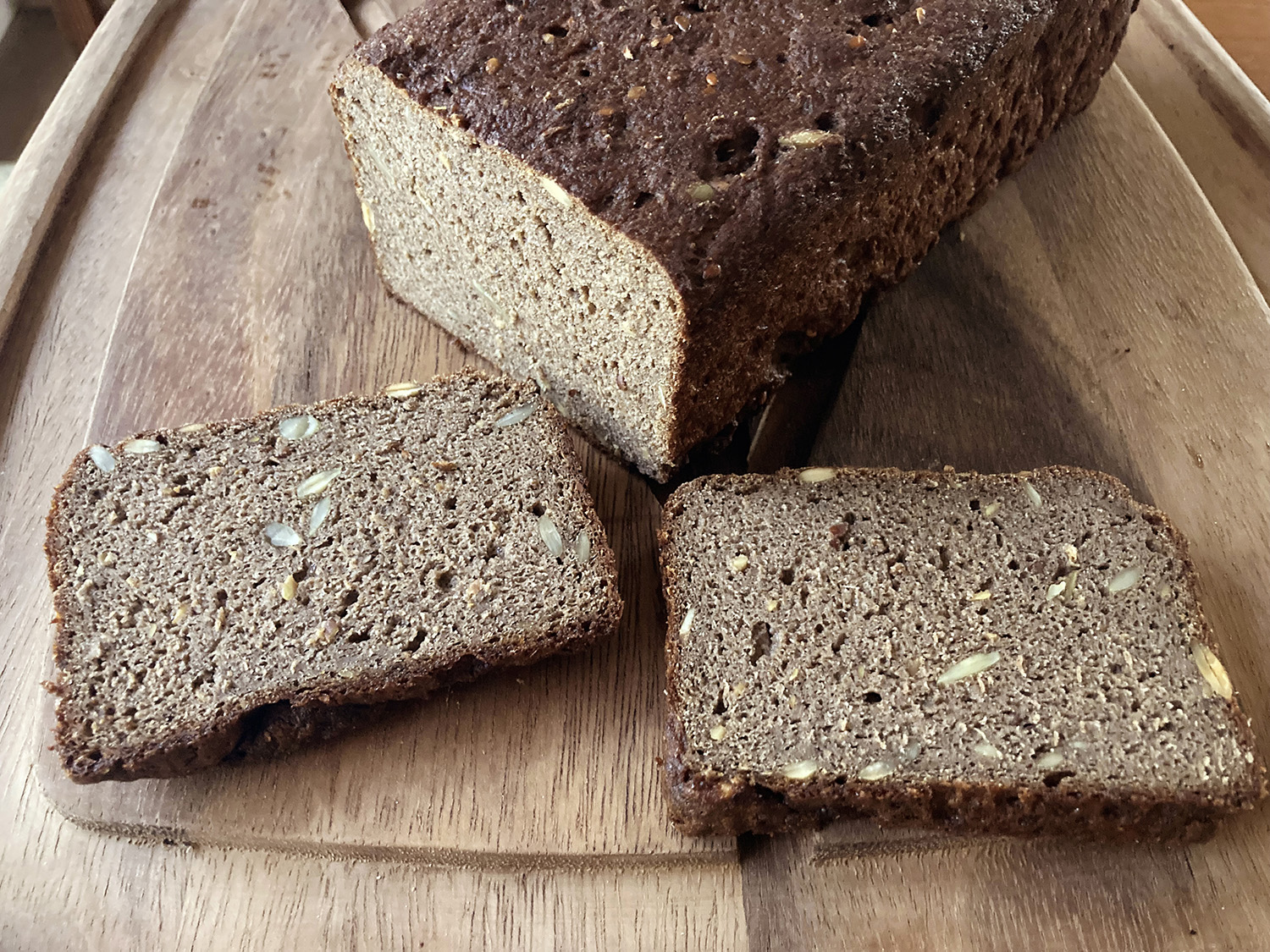
Gluten-free Pumpernickel Style, Mock-Rye Bread

Hello TFL! It's been a long time since I posted here. I was perusing around and noticed that rye bread is the theme of the season. I happen to be developing a rye-style gluten-free bread so I thought I'd share it here and see what people think.

This bread is:
- A tinned sandwich loaf
- 100% whole grain
- A complex, dark bread in the style of rye bread
- Vegan
- Rice free
- Yeasted (I'm working on an SD version too)
Pumpernickel Style, Mock-rye Bread
In the bowl of a stand mixer with the paddle attachment, or mixing by hand if you are strong and determined, mix the dry ingredients:
450g flour comprised of:
150g brown teff flour
125g dark buckwheat flour
90g quinoa flour
85g sorghum flour
2T flax seed, whole
25g whole psyllium husk/flakes
3g/1 tsp yeast
8.5g salt
1 tsp ground caraway (optional)
1 tsp ground coriander (optional)
After the dry ingredients are mixed thoroughly, mix in the wet ingredients:
540g water at room temperature
30g/1.5 TBSP molasses (or more for a sweeter bread)
12g/1 TBSP apple cider vinegar (optional)
Mix the ingredients together thoroughly for a few minutes, then let rest for 20 minutes. In the meantime, grease or oil a loaf pan, standard range of size. The smaller the pan, the taller the slices will be. A pan larger than 10x23 cm/4”x9” will result in a very short loaf.
Mix in, if desired:
1/4 C Pumpkin seeds (optional)
Mix for a minute or two, or until the seeds are evenly distributed. Turn out into your greased or oiled bread pan. You can leave the top natural and fluffy or you can smooth it out. You can also put additional seeds on top if desired, they toast nicely.
Let rise at room temp for about 2 hours or until the dough has risen 1-2 cm/.5-1 inch, and the dough springs back more slowly when depressed with a finger. When the dough starts to rise, preheat the oven to 230°c/450°f.
Bake at 450, covered or steamed, for 15 minutes. If using a Pullman pan, just rest the cover on top of the pan. If not, form a tin foil tent over the loaf pan or use steam in the oven. After 15 minutes, remove the cover and bake for another 30 minutes. Take the pan out of the oven and gently/carefully take the bread out of the tin. Knock the bread on the bottom side with your knuckles. If it doesn’t have a distinct hollow sound, put it back in the oven, straight on the rack, and bake another 5 minutes or until it sounds hollow when tapped on the bottom. Cool on a rack.
Enjoy!
Notes:
This flour blend was developed specifically for this recipe. Here’s what each flour brings to the table.
Brown teff - dark in color and complex in flavor, teff also gives bread a spongy and springy texture and helps with structure due to its high amount of protein and fiber. It's said to taste and perform a little bit like rye, but without any gluten.
Dark Buckwheat - this buckwheat is ground from the unhulled buckwheat groat. It’s very high in fiber and protein. It adds structure but it’s also very dense. It adds a good whole-grain texture to the blend as well as darkening the color considerably. The flavor is intense and a little bitter. It balances out the sponginess of the teff by being a little dry when baked.
Sorghum - this is a widely available grain that adds structure, fluffiness, and bakes off dry to help prevent gumminess.
Quinoa - I recently re-discovered quinoa after coming across a few experiments posted here on TFL by Juergen Krauss. I noticed that some of his quinoa bakes got incredibly good browning, something that is lacking in most GF grains. Quinoa has a lot of great attributes. In spite of being high in fiber and protein, it bakes off very spongy and with a good level of moistness. It adds flexibility to the texture of breads I’ve tried it in. It pairs well with buckwheat for flavor. It does have a bit of bitterness to it but that is hidden in this recipe with the two darker grains taking over the flavor profile. Quinoa lends this bread a nice, thin, crisp crust that browns nicely.
Hydration, that is, the amount of liquids in a bread recipe, is not a constant. The ideal hydration for a bread can change with humidity, climate, altitude, temperature, the grind of the flours, pan size, bake time and temp, and personal preference. I have to wonder if gluten-free breads are more susceptible to variations in grind or humidity than wheaten breads because small changes in hydration can have a significant affect on the outcome. I developed this recipe in the Pacific Northwest where we have some humidity, about 30-87% while I was testing this recipe. I’m at about 300 feet above sea level. The first bake with a new recipe is always a trial run, and adjustments should be made to the amount of liquid going forward.
Gina E Kelley

I'm intrigued. I don't have any gluten sensitivities, but this looks like a bread I would enjoy, and it is very nutritious. Have you tried a sourdough variant? I'm also curious if a scald would add anything to the crumb. I love the flavor and nutrition of teff. You may be interested in this recent thread on injera, where teff batter is boiled with water to make an 'absit', which is then reincorporated to smooth out the batter.
Thank you! I have always meant to make injera, but haven't gotten around to it yet. My cousin made it recently and she told me the scald/gel is crucial. I believe it! I'll check out the thread, I bet there's a lot of good information there. I've also never done a scald but I'm thinking about incorporating it into a few recipes, including this one and a GF Japanese shokupan that I think might work with a new flour blend I'm developing. And yes, I have a sourdough version of this bread that just came out of the oven last night and I'm going to slice into it today to see if it came out better than my first attempt. I also think that the yeasted version of this recipe would be great with some teff discard subbed out for the regular teff.
Amazing looking gf bread. I made similar using soaked, fermented and blended buckwheat groats, but yours must be so much tastier!
I've been meaning to try the fermented buckwheat bread from Breadtopia made with buckwheat groats. My sister made it and really loved it.
It's quite popular in my country (Poland) among gf eaters. Very easy to make, as buckwheat ferments very easily. It may be a little stinky when the fermentation starts, but it totally vanishes in the oven
1645724397170.jpg
Since you developed the blend specifically for the recipe, i guess there’s no substitute for the teff flour?
Thanks Emily! I have never tried this myself, and don't know what the flavor would be, but I've had someone sub the teff for finger millet in one of my other recipes and it worked well. But yes, I did develop this flour blend specifically for this recipe with a specific flavor/texture in mind. I used teff because it's the most rye-like of any gf flour that I'm familiar with.
Good to know finger Millet might work, it’s easier to buy it where I live than teff flour. Thanks again for getting back to me on this :)